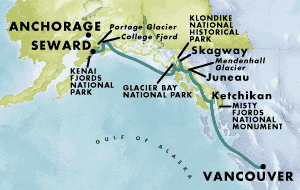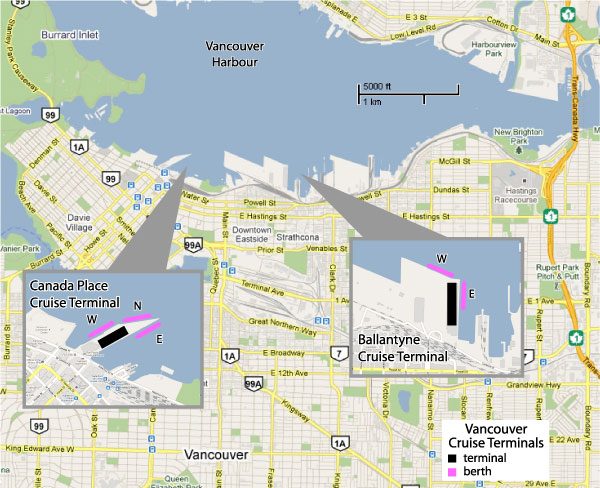

|
|
|
|
Seven Day Northbound Gulf of Alaska Cruises from Vancouver BC or Southbound from Seward or Whittier Alaska
Why should you choose a 7 day northbound or southbound cruise over a roundtrip from Vancouver or Seattle?
Simple - If you are doing a 7 day roundtrip Inside Passage cruise, you are only going as far north as either Glacier Bay or Hubbard Glacier. The second half of your trip is going back the same way you came. It is a great trip, but in reality, you are only seeing a small part of Alaska, only about 28% of it. If you do a Gulf of Alaska cruise, you continue northward from Glacier Bay across the Gulf of Alaska into Prince William Sound, among the most pristine and beautiful places on earth. You are treated to spectacular views of College Fjord and the Ivy League Glaciers. You will be glad you went. You will then travel on to Seward through Kenai Fjords National Park, an incredible place to view marine wildlife. From Seward, you will travel across the Kenai Peninsula to Anchorage. From Anchorage, you will catch your flight home. The additional scenery and wildlife viewings will be rewarding. You will have seen much more of Alaska which will lead to a much richer experience.
Here are the places you will visit on a typical Gulf of Alaska cruise. Your itinerary will include some, but not all of these ports of call. If you are doing a southbound cruise, the order would be reversed
Vancouver BC - Scenic and sprawling, Vancouver is fronted by the Pacific, backed by the alluring Coast Range and dotted with green parks. The city's busy waterfront is within walking distance of its business center. Nearby you'll find leafy Stanley Park, exotic Chinatown and many fine museums.
Inside Passage Cruising - Enjoy such stunning sights as green islands, sparkling glaciers, and a coastline that features the most majestic of mountains as you cruise the Inside Passage.
Juneau - Accessible only by sea or air, Alaska's modern capital city maintains the trappings of its 1880's gold-rush era. Discover the Capital building, historical distric and the infamous Red Dog Saloon. Nearby, explore the Mendenhall Glacier, a massive river of blue ice.
Ketchikan - Built on an island along the watery Inside Passage of the southern end of Alaska, Ketchikan exudes a frontier spirit. It is known for its many totem poles, dramatically carved by Indian artists. Visit the quaint houses and shops on historic Creek Street, built on stilts along a stream.
Skagway - When gold was discovered in the Klondike, the settlement of Skagway grew overnight from one cabin into a city of 20,000. The prospectors finally left, but the false-front buildings and boardwalks remain. Taste the history at the Red Onion Saloon or at the Klondike Gold Rush National Historical Park.
Sitka - Bounded by towering mountain peaks and the Alaska Marine Highway, Sitka boasts two pasts, as a Tlingit Indian village and as the capital of Russian America. Capture the spirit of both legacies at Sitka National Historic Park or at the elaborate Russian Orthodox St Michael's Cathedral.
Icy Strait - Greys, Minks, Humpbacks and Orcas are just some of the impressive whales you may encounter along the Icy Straits in Alaska. With a forest-like atmosphere, the Straits offer a main feeding area for many marine mammals. Hiking or kayaking will be the perfect way to view these amazing mammals in their natural habitat.
Haines - This historic town occupies a breaktaking setting on a peninsula along the deep blue waters of the Lynn Canal. Its Tlingit Indian heritage is preserve through art and dance at the Chilkat Center for the Arts. Visit the Chilkat Bald Eagle Preserve to see Alaska's most magmificent birds.
The Glaciers - Typically you will only visit one of these Glaciers (You won't be disappointed with any of them!)
Hubbard Glacier cruising - Hubbard Glacier, longest tidewater glacier in North America, begins its 76 mile journey to the sea on the slopes of Mount Logan, the tallest moutain in Canada and part of the largest non-polar icefield in the world. At the point where it enters Disenchantment Bay, at the head of Yakutat Bay, it is 6 miles wide. Hubbard Glacier has been known to advance so fast that it dammed Russell Fjord and created a lake behind it, trapping many marine species. A dozen years after this phenomenon, the dam no longer exists, and Hubbard is no longer the galloping glacier it once was. But the continent's greatest tidewater river of ice stilll flows at a fast trot, regularly disgorging enormous calves into the waiting arms of the sea.
Glacier Bay cruising - With it's snow capped mountains rising to over 15,000 feet, Glacier Bay is one of America's most spectacular National Parks. Made up of a grand collection of jagged glaciers comprising an entire array of ecosystems, lush forests and protected coves open way to beautiful saltwater beaches and jewel-like lakes. Glacier Bay National Park and Preserve, a 65-mile-long fjord, is a marine wilderness park, a living laboratory for observing the ebb and flow of glaciers, and a chance to study life as it returns in the wake of retreating ice.
Tracy Arm cruising - Tracy Arm is a narrow 26-mile winding fjord that was once a glacier filled valley and is lined with sheer ice carved walls rising thousands of feet on each side. This spectacular fjord gives you a look at terrain most recently exposed by the retreating glaciers of the last ice age. Countless numbers of waterfalls appear at each turn. Icebergs make their way out to sea in all sorts of wonderful shapes. Mountain goats cling to the sheer cliffs of the fjord. The fjord ends spectacularly with the twin Sawyer Glaciers.
In addition to the ports and glaciers you would see on an Inside Passage cruise as described above, on a Gulf of Alaska cruise you will also see some of the following depending on the cruise line and ship you are on.
Prince William Sound - contains some 3,000 miles of shoreline backdropped by enormous glaciers, dense forests, and the snow-topped Chugach Mountains. Within Prince William Sound are a multitude of islands of varying sizes, largest being 50-mile-long Montague Island. These islands act as natural breakwaters from storms in the Gulf of Alaska. Protected waters and the many small inlets provide excellent opportunities for exploration in sea kayaks and small boats.Prince William Sound gained notoriety during the devastating 1989 spill of oil from the Exxon Valdez. The impacts from that spill are still being felt in parts of the region, but visitors are not likely to see any direct evidence of the damage. This is still a very beautiful place.
College Fjord - At College Fjord, an inlet rimmed by icy crags, you sail past glacier after ghostly glacier. The first serious explorers here were financed by a group of Ivy League colleges, hence the name.
Seward - The original starting point of the Alaska Railroad, Seward retains the unspoiled air of a rustic fishing port. Not far from town is Harding Ice Field, an area three fourths the size of Rhode Island. Named for President Lincoln's U.S. Secretary of State William Seward, who negotiated the purchase of Alaska from Russia in 1867, this tiny fishing village is encircled by the Alaska Maritime National Wildlife Refuge, the Kenai National Wildlife Refuge, the Chugach National Forest and Kenai Fjords National Park. Otters, seabirds, black bears and moose are just a few of the area's inhabitants.
Whittier - At the head of the Passage Canal, originally was part of the portage route for the Chugach Indians of Prince William Sound traveling to fish the Turnagain Arm:later the Russians and Americans exploring the region also used this portage. It was used extensively by prospecting miners during the gold rush as it was the quickest passage from the Sound to the Cook Inlet and Interior regions.The city itself is a historical landmark, established by the U.S. Army during World War II. The Whittier railroad to Portage was completed in 1943 and became the primary debarkation point for cargo, troops, and dependents of the Alaska Command. In 1948 the military began construction of the first of two buildings for their military personnel as the Port of Whittier was then recognized as an ice-free, deep water port strategically located to Anchorage and Interior Alaska. The city of Whittier, incorporated in 1969, purchased the town site from the federal government in 1973. Today, less than 300 people reside in the town supporting the Alaska State Ferry, the Alaska Railroad, the Alaska Hydra Train, the military tank farm for aviation fuel, the Small Boat Harbor and tourism in general. You can see Birds, Sea Otter, Seal, Whale, Sea Lion, Porpoise, Glaciers, Waterfalls, (watch Horse Tail Falls flow up!) Goat, Deer, Bear and more in Whittier!
Anchorage - Surrounded by all the beauty and activities of Alaska, Anchorage offers a unique blend of spectacular scenery, Russian and Native heritage, Alaskan adventure and big city amenities.
Alaska's largest city lies between the Knik and Turnagain arms of Cook Inlet and the rugged Chugach Mountains. It is home to more than 240,000 residents, 40 percent of the state's population, and serves as the financial, communications and transportation hub of Alaska. The municipal boundaries stretch for more than 50 miles from Portage Glacier to the head of Cook Inlet and encompass 1,955 square miles.
Click here to see Gulf of Alaska Cruise Vacations


Cruise lines that Sail Northbound from Vancouver and Southbound from Seward and Whittier


Princess Cruise Lines
Holland America Cruise Lines
Carnival Cruise Lines
Royal Caribbean Cruise Lines
Celebrity Cruise Lines
Regent Seven Seas
Oceania
Disney Cruise Line
Norwegian Cruise Line
Un-cruise Adventures
Silversea
click here to see Gulf of Alaska cruise offers ![]()
ALASKA CRUISES AND LAND TOURS by CEALS
a division of Corporate Events and Leisure Services LLC (CEALS)
Washington Seller of Travel License # 603-078-647
Find an Alaska Cruise - Alaska Cruises - Alaska Cruisetours Cruise from Seattle Cruise from Vancouver BC Inside Passage cruises Gulf of Alaska cruises